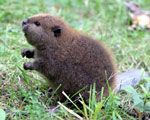
Photo by Jim Isaacs
Most of the calls about beavers center around damage done to plants or flooding. It is almost impossible to get rid of beavers. Even if one family is killed, another will move in the following year. It is better to live with the ones already in place, and just limit them to whatever the caller can afford to live with.
Destruction of dams will not work; it will only lead to more damage of trees.
Trees can be protected selectively by wrapping them in hardware cloth at least 3-1/2 feet up.
Beaver traps are specifically designed to hold beavers and are very expensive. Trapping will not really fix the problem.

Chipmunks eating plants
Chipmunks prefer tulips and dislike daffodils. If the caller prefers to have tulips, have him/her wrap the bulbs in hardware cloth. Another method to protect the bulbs would be to use a tin can, remove the lid and puncture several drainage holes into the bottom. Place the flower bulb and the dirt inside the can, and bury the can.
The only way to keep chipmunks out of an area is to remove their food source and their cover. Since they regularly raid bird feeders, either install a flange or some other exclusionary device or remove the feeder. Chipmunks hibernate during the winter months when the need for supplemental food for the birds is greatest.
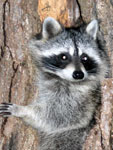
Photo by Beth Knapp-Tyner
Raccoon in the garbage can
Garbage cans can be secured by strapping the lid down with a bungee cord, and placing a rag, soaked in ammonia inside. Raccoons are intelligent and have excellent memories. It will take several weeks of securing the lid before the raccoon will stop visiting the can.
Raccoon in a dumpster
Place a rough board or a tree limb at a flat angle inside the dumpster to create an escape route.
More solutions to problems with raccoons can be found at
http://www.wildlife-museum.org/wildlife/solutions/raccoon.php
Skunks
All skunks 6 weeks of age or older will spray when threatened. Their aim is accurate up to 15 feet away. Usually a spraying incident will be proceeded by snarling, feet stamping, and raising of the hind legs and tail while turning. Skunk spray in the eyes can temporarily blind and should be flushed with lots of water immediately.
To help remove the odor when a person or pet is sprayed, wash with a mixture containing:
1 qt. 3% hydrogen peroxide (from the drugstore)
1/4 cup baking soda
1 tsp. liquid soap
Solutions to problems with skunks can be found at
http://www.wildlife-museum.org/wildlife/solutions/raccoon.php
Birds attacking people or pets
Birds are very protective of their young. If a "predator" approaches their nest, or a fledgling hidden on the ground, some species will "dive" at the intruder in order to drive him off. Advise the caller to stay out of the area for a few days. Birds do not get rabies.
Birds attacking window or cars (reflective objects)
Birds can not distinquish between a real rival and a reflection of themselves. Territorial birds (especially cardinals and mockingbirds) will often peck at windows or even chip the paint off highly polished cars. Hanging wind chimes, or placing rubber snakes in the area of the window may help.Cover the window or spray it with starch, soap or xmas glitter. Covering the car with a drop cloth, or simply letting it get a little dirty may discourage the bird from pecking.
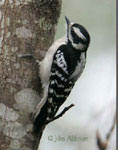
Photo by John Althouse
Preceeding mating season a male woodpecker will mark his territory by drumming.
Woodpecker drilling on side of house
If the woodpecker drills small holes into wood siding, call an exterminator and have the wood checked for destructive insects such as termites or carpenter ants. Woodpeckers feed predominantly on such insects. Woodpeckers nest in old, often dead trees. Wooden siding is similar enough. If you discover a woodpecker is drilling a rather large hole in the side of your house, and removing the insulation, he is getting ready to build a nest in your wall. Patch the hole. Be prepared to repeat this procedure for several days, as the bird will not give up easily. Use rubber snakes and other deterrents. Consider that it may be time to re-stain the house.
More information on woodpeckers can be found at http://www.wildlife-museum.org/wildlife/solutions/woodpecker.php
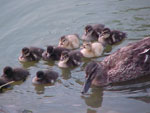
Photo by Jennifer Gordon
Nuisance geese
Domestic geese and ducks can be removed and relocated. Wild geese and ducks are protected. A source of information on the control of geese is found at the Coalition for Canada Geese website.
Goose nesting on property
A nest can be removed as long as there are no eggs present. Repeatedly removing nesting materials usually will force breeding waterfowl to relocate, build a new nest or nest later in the season. Nest construction may last for several weeks and the first egg may be laid less than 24 hours after the nest is constructed. Once the first egg is laid in a nest, the nest and eggs are protected by law.
More information on duck and geese rescue
Information on duck rescue and duck rehabilitators is found at http://www.duckrescuenetwork.org/
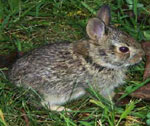
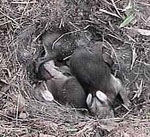
If the bunny's eyes are open, out of the nest, and approximately the size of a fist (covers the palm of your hand), it is a self-feeder. Leave it alone.
Sometimes bunny nests are damaged by machinery or predators. If the bunnies are still in the nest, they are not completely weaned. As soon as possible, restore the nest. If the nest has been disturbed for some undeterminable amount of time, it may be wise to check the babies for dehydration. If the bunnies are healthy, place them back and restore the nest. To check if the mother is coming back to feed the bunnies, place two pieces of string or yarn over the nest forming an x-mark and check back a couple of hours after sunrise or dawn. If the x-mark has moved, the mother has been there. If it has not moved, and if the bunnies feel cold to the touch, remove them and get in touch with a rehabilitator. If the babies look healthy, continue with the x-mark and wait until the next morning or evening to check back. Bunnies feed only three times a day as newborns, and at weaning the mother will only see them once every 24 hours.
Check for injury. If there are injuries, they should be referred to a rehabilitator. All bunnies that are well should be placed back, the nest restored, and the x-mark procedure followed.
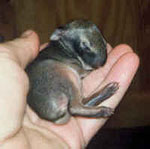
Baby bunny brought in by dog
If the bunny is uninjured, and it can be determined where it came from, put it back. Slight scratches and abrasions can be treated with betadine and Neosporin, and the bunny can be put back. More serious injuries need to be referred to a rehabilitator.
Baby bunny brought in by cat
Whereas dogs generally just "retrieve" a bunny, cats will "play" with them, often injuring them by scratching and biting. The combination of stress, and the type of bacteria present in the cat's mouth often spell doom for the bunny, even if the injuries do not seem serious. Most of these bunnies die within 24 hours unless given antibiotic. A rehabilitator should be called.
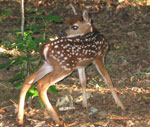
Photo by Beth Knapp-Tyner
The public often assumes that a found fawn is "abandoned", when in fact they are behaving normally. Lying still and quietly by themselves is normal for young fawns. The first few weeks of it's life, a fawn has no scent so is not easily detected by predators if it lays still. It's mother is typically close by and feeds the fawn periodically but doesn't stay with her fawn(s) continuously, so as not to attract predators. This is a normal survival tactic.
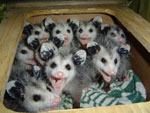
Photo by Linda Bergman
Baby opossum found away from mother
Not unless the mother is within earshot of the baby, will a mother opossum return to pick up a baby separated from her. The baby should be kept warm, dark, and quiet and a rehabilitator should be found immediately. Be sure to tell the caller not to give any water to the baby.
Dead opossum in road
Any time between January - November
a female opossum may have babies in her pouch. Even if the mother is dead, the pouch should be checked for surviving young. Gently pull the babies from the nipples, or just place the dead mother in a box and deliver her to a rehabilitator. Please also check the vicinity of the accident for babies which might have gotten thrown or walked away.
Baby squirrel on ground under tree
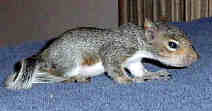 Baby squirrels can be blown out of the nest in heavy winds. Also, sometimes, for reasons of safety, a mother squirrel will move her litter to a new nest. She will do this by carrying them, one at a time. If a situation arises in which she feels threatened, she will leave the baby and hide. If a baby squirrel is found on the ground, remove all pets, children and other distractions such as noisy equipment from the area and observe from a safe distance. If she feels threatened she may not pick the baby up off the ground. If it turns dark outside before she picks up the baby, bring it inside and keep it warm, dark, and quiet overnight. Place the baby back, as soon as the sun is up. If the mother does not return, call a rehabilitator. Check if the baby is alert and hydrated. If it appears healthy, reuniting it with it's mother is the best solution. If it seems hurt, or weak, or even unconscious, call a rehabilitator. Some baby squirrels are genetically defective and are thrown from the nest on purpose.
Baby squirrels can be blown out of the nest in heavy winds. Also, sometimes, for reasons of safety, a mother squirrel will move her litter to a new nest. She will do this by carrying them, one at a time. If a situation arises in which she feels threatened, she will leave the baby and hide. If a baby squirrel is found on the ground, remove all pets, children and other distractions such as noisy equipment from the area and observe from a safe distance. If she feels threatened she may not pick the baby up off the ground. If it turns dark outside before she picks up the baby, bring it inside and keep it warm, dark, and quiet overnight. Place the baby back, as soon as the sun is up. If the mother does not return, call a rehabilitator. Check if the baby is alert and hydrated. If it appears healthy, reuniting it with it's mother is the best solution. If it seems hurt, or weak, or even unconscious, call a rehabilitator. Some baby squirrels are genetically defective and are thrown from the nest on purpose.
Baby squirrel brought in by dog
If the baby is uninjured and warm and you know where it came from, try reuniting it with its mother.
Baby squirrel brought in by a cat
Whereas dogs generally just "retrieve" a baby animal, cats will "play" with them, often injuring them by scratching and biting. The combination of stress, and the type of bacteria present in the cat's mouth often spell doom for the animal, even if the injuries do not seem serious. Most of these squirrels die within 24 hours unless given antibiotic. A rehabilitator should be called.
Frequently asked questions regarding injured adult animals
Deer hit by car
Any time an adult deer gets hit by a car, the law requires that the wildlife officer be contacted. Call 1-800-662-7137. After hours call the highway patrol, or the local sheriff. No attempt should be made to pick up the deer, as its legs are formidable weapons which can inflict serious injuries.
An adult squirrel can inflict painful and debilitating injuries on anyone trying to rescue it. An adult squirrel should only be picked up with heavy welding gloves in combination with a doubled over towel or blanket. Better yet, use tools. In case of doubt, it is better to place cardboard box over the animal and wait for help to arrive.
Frequently asked questions regarding baby birds
Baby chimney swifts in the fireplace
Often the caller will be alerted to the presence of baby swifts by their shrill, very loud chattering which may sound like a rattlesnake. Usually callers who are at first annoyed with the noise will quickly change their mind about the swifts if you explain their benefits. Swifts are insectivorous birds that eat 'on the wing' (during flight). One swift will consume more than 2,000 mosquitoes daily. Swifts used to nest in hollow, old poplar trees, but now often nest in chimneys. The young swifts hatch in the height of summer (June - August), when food is plentiful. If the caller wishes not to experience the same "problem" in the upcoming year, a chimney cap can be installed to keep the swifts from returning. Do this in November or December when the swifts have migrated south.
The chimney swift nest and/or birds dropped down
The swift nest consists of saliva and twigs. Occasionally it can come loose and drop inside the fireplace, or on top of the damper. The adult swifts are equipped to climb up and down the flue pipe, and will do so in order to feed the babies. Leave the damper alone and interfere only if they are inside the fireplace. If the baby swifts are inside the fireplace itself, advise the caller do the following:
Find some ravel-free material such as a sweatshirt or a t-shirt. Hang it over a broom, and place the baby swifts on the material so that they can hang there in a vertical position (bellies parallel to the flue pipe). Then, place the broom as far up into the flue pipe as possible. Swifts should be able to climb up the flue by themselves, once placed inside. Baby swifts that are cold or whose eyes aren't open should be sent to a rehabilitator.
Information on chimney swifts can be found at http://www.chimneyswifts.org/
The most common call rehabilitators receive is one regarding fledgling birds. Often the caller does not understand that he is describing a healthy bird in a natural stage of development. The caller often states that the bird is an adult bird that cannot fly or a bird with a broken wing. The fledglings of any species of songbird resemble the parent bird in size and appearance; fledglings most often have shorter tails. Once the fledgling leaves the nest, it will take it several days, on the average, to learn how to fly. The parents will be feeding the fledgling for the next few weeks until he becomes fully self-feeding. It will be hiding in brush and bushes, and should be relatively safe from predators. If obsered from a distance you can see the parents stopping by occasionally to feed the youngster. If you observe such a situation, clear all children and pets from the area so that the parents can attend to their baby.
Baby bird, fallen from nest
Sometimes, especially after a storm, a baby could be found outside a nest. Simply place the baby back. If the nest can not be reached, create an artificial, substitute nest. A small basket, a plastic strawberry basket, or a flower pot will do fine. If using a plastic container, be sure to cut a drainage hole in the bottom so that the baby does not drown in case it rains. Fasten this "nest" securely to the nearest object or to the original location of the bird nest. Place the baby inside and observe the baby from a distance. If it gets dark outside, bring the baby inside and keep it warm, dark, and quiet overnight. Try placing it back outside just as soon as the sun comes up.
Baby bird nest has fallen
If the nest is structurally sound, return it to the original site, or at least as close to it as possible. If the nest is destoyed, place it inside a basket or other container and return it to the site.
Most birds have little sense of smell. It does not matter if a human has held the baby or not. The parents will be happy to have the baby back.
Bird brought in by a cat
Whereas dogs generally just "retrieve" a bird, cats will "play" with them, often injuring them by scratching and biting. Often the puncture mark is not even noticed by the caller. The combination of stress, and the type of bacteria present in the cat's mouth often spell doom for the bird, even if the injuries do not seem serious. Most of these birds die within 24 hours unless given antibiotic. A rehabilitator should be called.
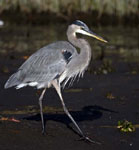
Photo by Linda Bergman
Herons
Herons are large birds which feed primarily by spearing fish, frogs, snakes and small rodents. PLEASE NOTE THAT HERONS ARE VERY DANGEROUS. When approaching herons always wear safety goggles (not eye glasses or sunglasses). As a means of defense the bird can throw back his head and spear directly for your eyes. People have lost not just eyes, but have been killed by herons. Capturing this bird should not be attempted by inexperienced people.
During certain light conditions, window panes become invisible to birds, and they hit them in flight. The bird will be stunned, sitting very still, sometimes the head leaning to one side. Often this is not a serious injury and can be handled by the caller. Unless there are other injuries such as a broken wing, have the caller place the bird in a box and keep it warm, dark, and quiet for a couple of hours. If the bird is still unable to fly, have the caller contact a rehabilitator.
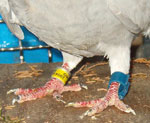
Photo by Elizabeth Hanrahan
Racing pigeons can be returned to their owners by tracking the number on the band. If these pigeons are uninjured, they should be kept overnight and fed and watered. Often they just suffer from exhaustion and can be released.
For more information on banded birds go to http://ncwildliferehab.org/newsletter/WRNCNewsletter_Jun05.html.
| Pigeons (World of Wings)(IF or UA bands) | 800-882-1586 |
| American Racing Pigeon Union (UA band) | 800-755-2778 |
| Banded Waterfowl | 800-327-2263 |
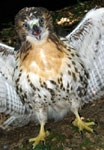
Photo by Jean Chamberlain
Raptors are carnivorous and they are well equipped for tearing flesh. A raptor must therefore be approached with the utmost care. Wearing protective clothing and heavy gloves is a must. It also helps to know the behaviors specific to the species. Hawks prefer to throw themselves on their back and defend themselves with their talons. Owls will use their beak as well as their feet. A vulture will want to peck, but also vomits as a means of defense. If the bird is on the ground, the easiest way to catch him is by pacing a cardboard box over him. A heavy blanket could also be used (wearing heavy gloves). Never try grabbing at him with your hands: someone will be hurt! It is always recommended that the caller find an experienced raptor rehabilitator to capture the bird.
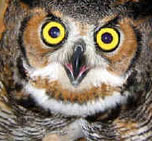
Photo by Jean Chamberlain
Before any attempt is made to free the owl, secure the talons. Do not attempt to remove the wire from the wing as that will only damage it further. Cut the wire on either side of the wing, keeping the barbs from moving against the wing. While one person is securely holding the body of the owl, the other person will cut the wire on either side of the wing. Freeing a raptor from barbed wire is dangerous and is best done by someone experienced in handling raptors.